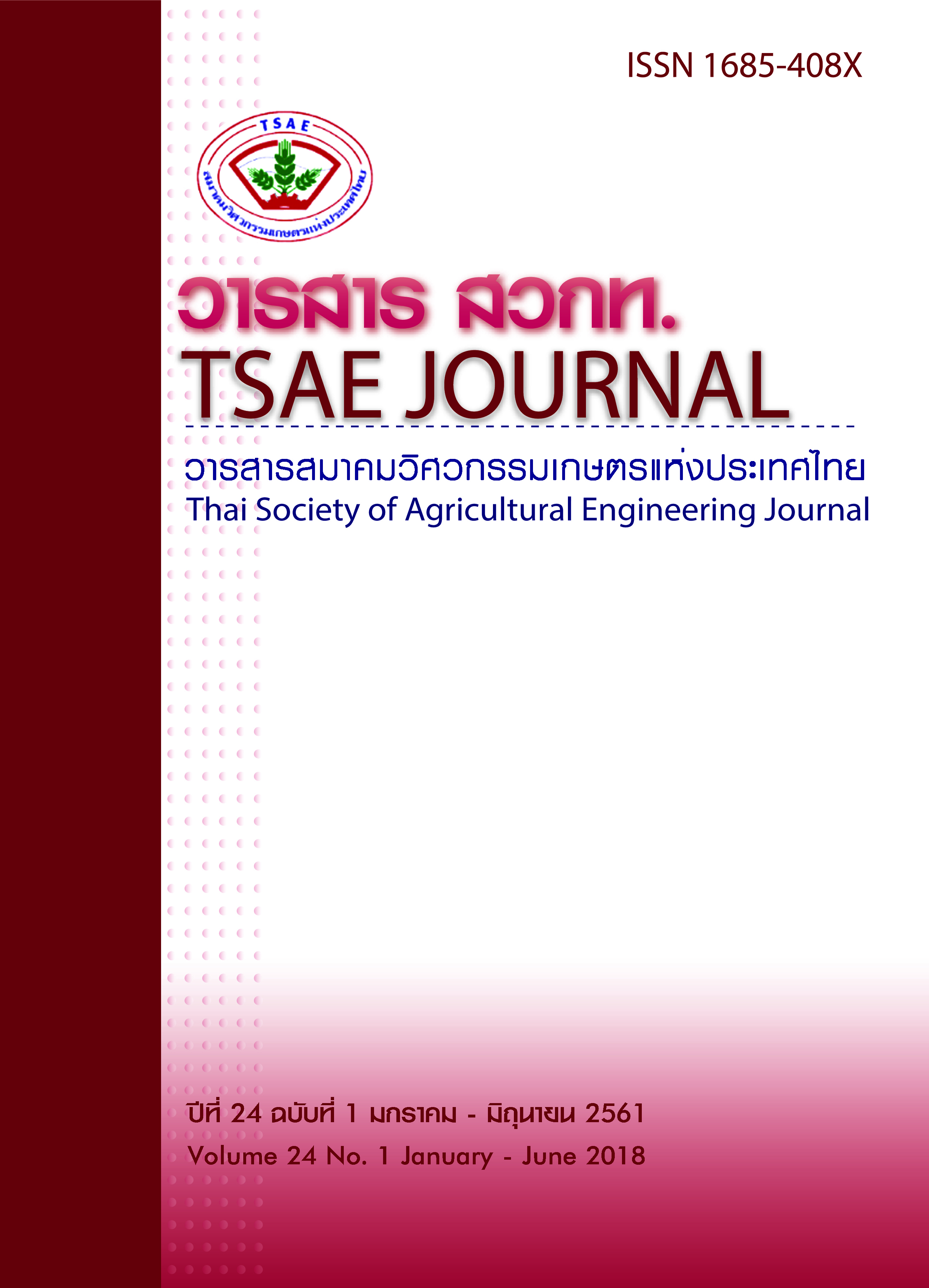A STUDY ON CHILI DRYING PROCESS USING A PILOT-SCALE HOT AIR AND MICROWAVE DRYER
Main Article Content
บทคัดย่อ
The hot air and microwave dryer can be used in harvested agricultural production drying to reduce drying times. Product quality is important in the drying process, which should study specifically agricultural production. Hence, the objective of this project was to study the characteristics of dried chilies, energy consumption, and production costs of chili drying using the pilots-scale hot air and microwave dryer. The design of the pilot-scale hot air and microwave dryer features microwave heat generation from six 2450 MHz frequency magnetrons in a 210 L of capacity enclosure with a 5000 W air heater running at 180 ºC at maximum temperature in a closed loop-heating system. The temperature in the oven chamber is controlled automatically for both microwave and air heat generation. The study showed that the chili drying process using the hot air and microwaves dryer yielded shiny red skin, green calyx without skin cracking and the production costs of 35 baht kg-1dry chilies . As a result, the chili drying process using the hot air and microwave drying is the most suitable for further development on a commercial scale because of its clean technology, short drying times, and high quality of production.
Article Details
สมาคมวิศวกรรมเกษตรแห่งประเทศไทย
Thai Socities of Agricultural Engineering
References
คำนึง วาทโยธา. 2553.การศึกษาการอบแห้งยางแท่งด้วยเตาไมโครเวฟระดับขยายส่วน.รายงานการวิจัยฉบับสมบูรณ์โครงการการศึกษาการอบแห้งยางแท่งด้วยเตาไมโครเวฟระดับขยายส่วน.สำนักงานกองทุนสนับสนุนการวิจัย (สกว.) สนับสสนุนงบประมาณวิจัย.ศูนย์นวัตกรรมเทคโนโลยีหลังการเก็บเกี่ยวมหาวิทยาลัย ขอนแก่น.
จิรวัฒน์ กันต์เกรียงวงศ์ วรพจน์ สุนทรสุข และประเวทย์ ตุ้ยเต็มวงศ์. 2549. การผลิตพริกแห้งแบบใหม่โดยเครื่องไมโครเวฟสูญญากาศแบบถังหมุน วารสารวิทยาศาสตร์เกษตร ปีที่ 37 ฉบับที่ 2 (พิเศษ).178-181.
นาริสา บินหะยีดิง ปิยาภรณ์ ภาษิตกุล และวิภา พลันสังเกต. 2553.อิทธิพลของสารกับการเปลี่ยนแปลงสีของพริกชี้ฟ้าแห้ง. The 36th Congress on Science and Technology of Thailand. 26 - 28 ตุลาคม 2553. ณ กรุงเทพ มหานคร.
ผดุงศักดิ์ รัตนเดโช. (2551). พื้นฐานการทำความร้อนด้วยไมโครเวฟ. กรุงเทพมหานคร: สำนักพิมพ์มหาวิทยาลัย ธรรมศาสตร์.
สาวิตรี คำหอม. 2552. การศึกษาการประยุกต์เตาอบไมโครเวฟในกระบวนการนึ่งปาล์มน้ำมัน.วิทยานิพนธ์ปริญญาโท วิศวกรรมเครื่องกล มหาวิทยาลัยเทคโนโลยีสุรนารี.
Funebo,T. and Ohlsson,T. 1998. Microwave - assisted air dehydration of apple and mushroom. Journal of Food Engineering. 38,353-367.
วีระ ภาคอุทัย และ เยาวรัตน์ ศรีวรานันท์.2557.พริกปลูกอย่างไรในสภาวะโลกกำลังร้อน.สำนักงานกองทุนสนับสนุนการวิจัย.เล่มที่ 4.
เหมการ์ จินดาวัฒนภูมิ.2545.การศึกษาแบบจำลองการทำแห้งระบบสูญญากาศร่วมกับไมโครเวฟกับพริกไทย.ปริญญาวิศวกรรมศาสตรมหาบัณฑิต สาขาวิชาวิศวกรรมอาหารคณะวิศวกรรมศาสตร์ มหาวิทยาลัยเทคโนโลยีพระจอมเกล้าธนบุรี.
สารานุกรมไทยสำหรับเยาวชน.การถนอมผลิตผลการเกษตร .เล่มที่ 19, เรื่องที่ 3.
เทวรัตน์ ทิพยวิมล.2551. การพัฒนาเครื่องอบแห้งระบบปั๊มความร้อนร่วมกับไมโครเวฟเพื่ออบแห้งสมุนไพร.วิทยานิพนธ์ ปริญญาเอก วิศวกรรมเกษตร มหาวิทยาลัยเกษตรศาสตร์.
จันทรา ดิษฐนา.2549. การทำแห้งดอกกุหลาบด้วยระบบปั๊มความร้อนและสูญญากาศ.วิทยานิพนธ์ วิทยาศาสตร์มหาบัณฑิต สาขาวิชาวิทยาการหลังการเก็บเกี่ยว มหาวิทยาลัยเชียงใหม่.
Tulasidas T.N., Raghavan ,G.S.V. and Mujumdar, A.S .1995.Microwave drying of Grapes in a Single mode cavity at 2540 MHz I: Drying Kinetics. Drying Technology, 13 , 1949-1971.
Ozkan, I.A., Akbudak, B and Akbudak N.2005. Microwave drying characteristics of spinach.Journal of Food Engineering. 78, 577-583.
Soysal, Y. 2004. Microwave drying characteristics of parsiey. Biosystems engineering.89 (2),167-173.

